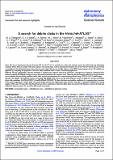Por favor, use este identificador para citar o enlazar a este item:
http://hdl.handle.net/10261/84726COMPARTIR / EXPORTAR:
 SHARE SHARE
 CORE
BASE CORE
BASE
|
|
| Visualizar otros formatos: MARC | Dublin Core | RDF | ORE | MODS | METS | DIDL | DATACITE | |

| Campo DC | Valor | Lengua/Idioma |
|---|---|---|
| dc.contributor.author | Thompson, Mark A. | - |
| dc.contributor.author | Cava, Antonio | - |
| dc.contributor.author | Herranz, D. | - |
| dc.contributor.author | Lagache, Guilaine | - |
| dc.contributor.author | López-Caniego, M. | - |
| dc.contributor.author | Verma, Aprajita | - |
| dc.date.accessioned | 2013-10-22T09:14:19Z | - |
| dc.date.available | 2013-10-22T09:14:19Z | - |
| dc.date.issued | 2010 | - |
| dc.identifier | doi: 10.1051/0004-6361/201014639 | - |
| dc.identifier | issn: 0004-6361 | - |
| dc.identifier | e-issn: 1432-0746 | - |
| dc.identifier.citation | Astronomy and Astrophysics 518: L134 (2010) | - |
| dc.identifier.uri | http://hdl.handle.net/10261/84726 | - |
| dc.description | Thompson, M. A. et al. | - |
| dc.description.abstract | Aims. We aim to demonstrate that the Herschel-ATLAS (H-ATLAS) is suitable for a blind and unbiased survey for debris disks by identifying candidate debris disks associated with main sequence stars in the initial science demonstration field of the survey. We show that H-ATLAS reveals a population of far-infrared/sub-mm sources that are associated with stars or star-like objects on the SDSS main-sequence locus. We validate our approach by comparing the properties of the most likely candidate disks to those of the known population. Methods. We use a photometric selection technique to identify main sequence stars in the SDSS DR7 catalogue and a Bayesian Likelihood Ratio method to identify H-ATLAS catalogue sources associated with these main sequence stars. Following this photometric selection we apply distance cuts to identify the most likely candidate debris disks and rule out the presence of contaminating galaxies using UKIDSS LAS K-band images. Results. We identify 78 H-ATLAS sources associated with SDSS point sources on the main-sequence locus, of which two are the most likely debris disk candidates: H-ATLAS J090315.8 and H-ATLAS J090240.2. We show that they are plausible candidates by comparing their properties to the known population of debris disks. Our initial results indicate that bright debris disks are rare, with only 2 candidates identified in a search sample of 851 stars. We also show that H-ATLAS can derive useful upper limits for debris disks associated with Hipparcos stars in the field and outline the future prospects for our debris disk search programme. © 2010 ESO | - |
| dc.language.iso | eng | - |
| dc.publisher | EDP Sciences | - |
| dc.rights | openAccess | - |
| dc.title | A search for debris disks in the Herschel -ATLAS | - |
| dc.type | artículo | - |
| dc.identifier.doi | 10.1051/0004-6361/201014639 | - |
| dc.relation.publisherversion | http://dx.doi.org/10.1051/0004-6361/201014639 | - |
| dc.date.updated | 2013-10-22T09:14:20Z | - |
| dc.description.version | Peer Reviewed | - |
| dc.type.coar | http://purl.org/coar/resource_type/c_6501 | es_ES |
| item.openairecristype | http://purl.org/coar/resource_type/c_18cf | - |
| item.fulltext | With Fulltext | - |
| item.cerifentitytype | Publications | - |
| item.openairetype | artículo | - |
| item.languageiso639-1 | en | - |
| item.grantfulltext | open | - |
| Aparece en las colecciones: | (IFCA) Artículos (IAS) Artículos | |
Ficheros en este ítem:
| Fichero | Descripción | Tamaño | Formato | |
|---|---|---|---|---|
| search_debris_Thompson.pdf | 728,54 kB | Adobe PDF |  Visualizar/Abrir |
CORE Recommender
SCOPUSTM
Citations
15
checked on 11-abr-2024
WEB OF SCIENCETM
Citations
13
checked on 26-feb-2024
Page view(s)
325
checked on 17-abr-2024
Download(s)
209
checked on 17-abr-2024
Google ScholarTM
Check
Altmetric
Altmetric
NOTA: Los ítems de Digital.CSIC están protegidos por copyright, con todos los derechos reservados, a menos que se indique lo contrario.
